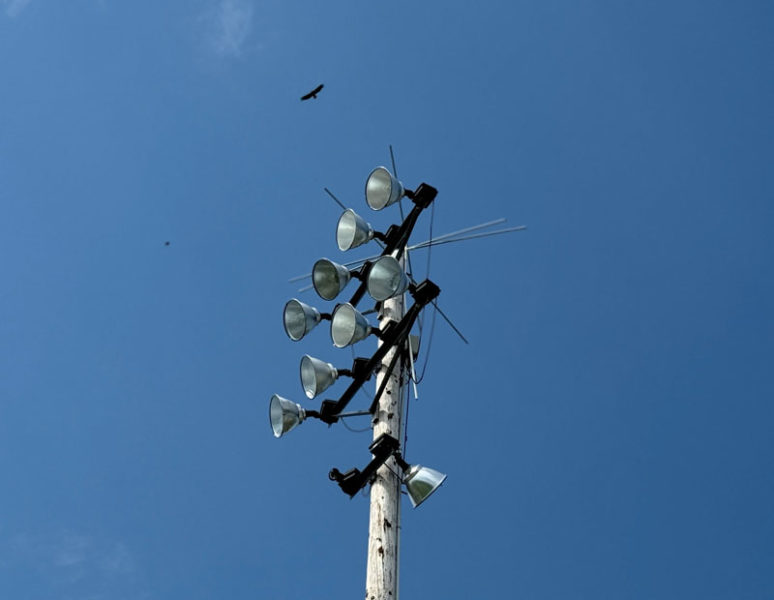
One of two remaining light poles at Lincoln Academy in Newcastle stands adorned with PVC to deter ospreys from rebuilding their nest on Thursday, May 23. School officials have been working with a wildlife biologist to safely deter the raptors from building their nests so the school can replace the deteriorating poles and antiquated lighting system. (Johnathan Riley photo)
At Lincoln Academy in Newcastle, school administrators’ efforts to safely deter osprey from nesting on antiquated light poles surrounding the turf field yielded fruit on Thursday, May 23, with staff members believing the birds have ceased their rebuilding attempts.
According to Head of School Jeff Burroughs, the school has been taking the upmost care in considering the safety of the birds while balancing the needs of the school during the transition to new, safer lighting equipment and poles.
The process to replace the lights began in mid-January, according to Burroughs. When the school took down the osprey nest and discovered the wood the nest was constructed with had been turned to charcoal by the prolonged contact with the old, overheating lights.
“I can’t even believe it hadn’t caught on fire,” he said. “They’re building on top of these, basically, heat lamps because they are such old technology.”
Before the school removed the first pole that was the home of the original osprey’s nest since the 1990s, administrators first flew a drone equipped with a camera to the top of the pole and confirmed the birds had not laid an egg, Burroughs said.
When the school took down the first pole on May 10, it was so rotten “it split in half,” Burroughs said.
“You could poke a pencil through it,” he said of the constitution of the wood.
A week later, to further deter the birds, the school removed a second pole.
“We’re trying to encourage the birds to go find the right thing for them because there is so much nesting opportunity around the school,” Burroughs said.
Mayher said there are plenty of tall pines nearby that would be ideal, safe nesting locations.
Burroughs said from the school’s perspective, removing the nest and replacing the poles was a necessity because the dangers presented to the community.
“We don’t need a flaming nest falling onto the field during a soccer game,” said Jenny Mayher, the school’s communications director.
The school has been consulting with Dr. Erynn Call, a raptor biologist that works for the Maine Department of Inland Fisheries and Wildlife, in order to navigate the safest possible way forward with the ospreys, according to Mayher.
At the suggestion of Call, PVC has been placed on the two remaining poles with the help of the Newcastle Fire Department to disrupt the osprey from rebuilding a nest before the poles are removed this summer.
However, the PVC didn’t stop a couple of miffed ospreys from attempting to rebuild their seasonal home. While the pipe was a deterrent, the birds still tried wedging sticks between it and the lights, according to Mayher.
“They really made a valiant effort,” Burroughs said.
While the birds were ultimately unsuccessful, according to Mayher, it’s been difficult for the community to watch.
“People are sad because the osprey are dropping sticks trying to rebuild, and it is sad, but we were in a position where to function as a school, we need those lights,” Mayher said.
Mayher said that the best scenario for the osprey would have been if the school was able to take all the poles down in the wintertime. However, she said taking down the poles then would have significantly impacted the school spring sports schedule, which the administrators weren’t interested in.
“The turf field is in constant use during the sport season for practices and games,” Mayher said. “If we had taken the poles down in the wintertime, we wouldn’t have had a spring sports season, so we had to leave the lights up until the spring when they could be replaced.”
Burroughs said since the removal of the first pole on May 10, no more night games were held on the turf field. With lengthening days and some accommodations in the scheduling, the impact of the lights removal is minimal.
Aside from the safety concerns, the impact of the new light system will be significant, both environmentally and for spectators and players alike. According to Facilities Director Casey Stevens, the new light system will be made of LED bulbs that will improve the viewing experience over the previous halide lamps, reduce light pollution, and use up to a third less energy.
The new poles going in over the summer will be made of steel with a concrete foundation, replacing the wooden poles that were situated 10 feet underground. Additionally, there will be a new sound system installed on the poles that will provide clearer announcements during games.
According to Mayher, the installation of the new lights will be completed before the fall sports season begins.
For more information about the school and the project, go to lincolnacademy.org or call 563-3596, or email info@lincolnacademy.org.



